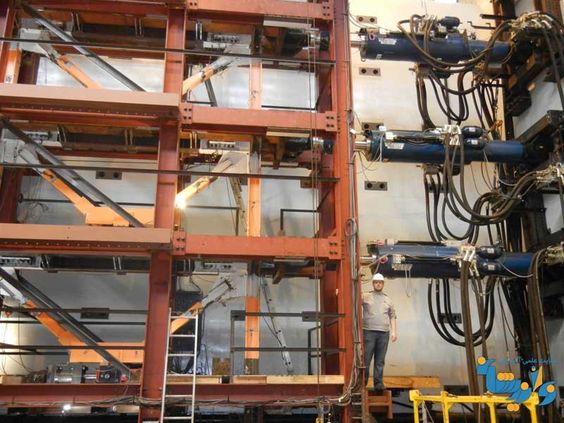
Retrofitting buildings
Nowadays, finding suitable solutions for strengthening buildings and repairing and strengthening industrial structures, oil and gas, offshore and… Considering that replacing existing structures with new structures is often not economically viable and also the possibility of stopping The activity of many of these structures, which are not part of the vital structures, has become very important. Wrong choice of an inappropriate method of building reinforcement can even worsen the performance of the structure. Also, strengthening an existing structure and retrofitting buildings can be even more complex than building a new one; Because the condition of the structures is already proven, and in addition, it is not always possible to easily access the areas that need reinforcement in structures and buildings.
Types of retrofitting performed by Istaban Consulting Engineers and the reasons for it:
For various reasons such as changing the use of the building, low strength of concrete, poor execution or design or adding floors, building owners face structural problems and sometimes legal obstacles and lack of approval of the supervising engineer or the organization of the engineering system. Maintaining strength and non-vulnerability and maintaining safety for the structure itself and humans need to strengthen and strengthen the main and fundamental components of the building.
Non-structural components include all components and contents inside the building except structural parts such as beams, columns, floors, etc. Common non-structural components in buildings include suspended ceilings, windows, office supplies, computers, shelves, drawers and drawers, heating, refrigeration and ventilation equipment, electrical appliances, furniture, lamps and chandeliers. Non-structural components are usually not analyzed by structural engineers, but by architects, mechanics, electrical engineers, or interior designers to determine their type and characteristics; Or, without the intervention of a professional designer, purchased and installed by landlords or tenants after construction.
Considering the performance of structures during earthquakes in recent decades, it has been observed that the performance of non-structural components play an important role in the operation of structures after an earthquake, for example in a hospital False ceilings or collapsed walls are inefficient, or in a residential building, due to the lack of use of wall posts, the walls may not engage with the columns and may collapse during an earthquake, causing severe damage due to the non-structural walls. Homeowners can reduce the loss and damage caused by the collapse of non-structural components by strengthening and strengthening non-structural components in the building.
Concrete structures as a large part of the structures, if designed and executed according to accurate calculations and ductility relationships, will be very desirable buildings, but the quality of construction in some structures is very poor for various reasons.
Poor quality of concrete, improper reinforcement, poor execution of concreting, substandard materials, design errors, execution errors, increased structural load, the impact of destructive environmental conditions and earthquake risk in most parts of Iran are among the factors that weaken concrete structures and the need They strengthen the building.
Many existing reinforced concrete structures, designed and implemented in accordance with pre-1970 regulations, have poor reinforcement details that cause problems such as low lateral displacement capacity, low energy dissipability, deterioration of the mechanism and the occurrence of unreacted mechanisms in the mechanism. All these cases lead to the collapse and destruction of the structure. Deformable details in a reinforced concrete structure in the form of such things as poor shear strength of the joint due to lack of transverse reinforcement in the joint, low shear capacity of the column leading to the joint, short overlap length of the column longitudinal reinforcement, non-observance of compression fitting Beam reinforcements are present in the connection area. Weakness in the area of joining the beam to the column together with the undesirable factor of the weak column-strong beam endangers the stability of the structure. The occurrence of the mechanism in the beam is preferable in comparison with the column and the column mechanism is more non-critical in comparison with the connection area. The appearance of the mechanism and the formation of the joint in the area of joining the beam to the column, has led to increasing periods in the beam and column, which causes the loss of bearing capacity of the column and affects the safety of the structure.
One of the oldest and most common types of buildings are buildings, so the reinforcement of a building is of special importance. As 30 out of 30 doors in buildings
Steel buildings, if properly designed and executed, have very good strength and ductility, but due to the lack of use of specialized executive forces and erroneous assumptions, the construction of steel buildings has disadvantages and problems that need to be strengthened and It has improvements. Steel buildings are often damaged and do not function properly under seismic loads due to local buckling. Or they need to be reinforced due to corrosion. In this article, an attempt has been made to strengthen steel buildings against seismic and gravity loads.
Restoration and retrofitting methods:
know more
know more
know more
know more
know more
know more
know more
know more
Work process of Eastabon Consulting Engineers

Perform specialized tests

Modeling and design
Provide resilience solutions

Follow up and consult the project until the end of the implementation
Employers and building owners
Some employers and contractors make executive mistakes when constructing a concrete and metal building, which reduces the building’s endurance in the face of factors such as earthquakes, and as a result, the building should be strengthened by providing a suitable reinforcement plan. Some common execution mistakes in different types of buildings are:
Demolition of beams to pass facilities
Lack of sealing of formwork and consequent leakage of concrete
Failure to observe the size of the beams according to the drawings and also non-observance of the thickness of the concrete cover of the beams
Alignment of executed concrete columns
Displacement of molds during concreting
Concreting of concrete after opening the molds
Wrong number and diameter of reinforcements used and their distance from each other
Moving the column plate during concreting the foundation
Failure to perform welding length in accordance with executive plans
Insufficient dimensions and welding of column patch sheets
There were not enough corners of the living room under the beams
Improper connection of the step beam or sword to the main beam
Improper connection of bracing members in metal buildings
Using old I-shaped profiles instead of bracing members in a metal building
Improper connection of the step step beam to the main beam
Another factor that requires us to provide a building reinforcement and seismic improvement plan is wear and damage to beams, columns and roofs during the operation of the building.
Common breakdowns in steel buildings include:
Corrosion
Disappearance and oxidation of pimples
Buckling in compression members
Complications of fatigue
And…
Also common failures in concrete buildings are:
Cracks in beams and columns
Corrosion and oxidation of rebars
Loss of concrete cover
Existence of damage in buildings makes members unable to perform the tasks assigned to them by the design engineer and accountant, and continuing to operate them without retrofitting and improvement can cause hazards and damage. Lots of lives and finances during phenomena such as earthquakes.
Each building is designed for a specific purpose and must meet the requirements of the relevant regulations to achieve the expected level of safety and stability. However, during the service life of a building, owners may want to change its use. For example, a residential building can be turned into a warehouse. Any change in the use of a building can cause more loads in the building so that the building with the same condition is not able to withstand the load and different gravity and lateral load-bearing members are broken. For this reason, and before implementing any change in the use of the building, it is necessary to carry out the necessary studies and studies and, if necessary, to present a suitable retrofitting plan.
During the operation of the building, it may be necessary to install heavy mechanical equipment in a part of the building. Installation of heavy mechanical equipment in any part of the building leads to an increase in the load on the building, as a result of which the building needs authority to increase its load-bearing capacity.
Supervising and consulting engineers
One of the issues that lead to structural weakness in the construction and construction of construction projects is executive errors. Common mistakes in buildings that force engineers to come up with a reinforcement plan to fix them are:
Improper quality and execution of concreting
Error in reinforcement
Use of low quality materials
Failure to observe the negative rise in the middle of the beam and long beams
Improper and unacceptable welding in steel structures
Format bug
Weakness of screws used in steel structures
Rupture of connection plates in steel buildings
Failure to observe the allowable tolerance at the end of the beam and at the connection to the metal column
Failure to comply with the rules and regulations in the implementation of non-structural components such as walls and blades
Connecting horizontal columns at the intersection of two adjacent buildings
These problems are more pronounced during an earthquake and in many cases cause the collapse and total destruction of buildings due to issues such as the formation of soft floors.
Factors influencing the occurrence of design errors that lead to the presentation of the reinforcement design can be very diverse, including:
Very strong design of braces and very weak columns in a simple articulated frame
Failure to calculate the bending capacity for shear design
The amount of reinforcement used is the minimum allowable recommended in the regulations
The amount of reinforcement required for an area of the column is more than the allowable limit recommended in the regulations
Lack of correct definition of properties of steel, concrete and rebar materials in computing software environment
Error in preparing executive plans
Many buildings that have been built for several years have been designed and built according to regulations and methods, which are now invalid and need seismic retrofitting and improvement for proper operation. For example, many structures built in the world until 1980, despite their great importance, are not earthquake resistant. The reason for this is the lack of sufficient knowledge and understanding of earthquakes at the time of construction of those structures.
Another important point that should be paid much attention to today is the study of past earthquakes. This measure is many times more important for us who live in a seismic region like Iran and helps to provide a more appropriate seismic reinforcement and improvement plan.
In some buildings, at the request of the building owner, it is necessary to change the use of the building or increase its floors. Any change in the structural system of a building can increase the dead and live load, the coefficient of importance of the building as well as the level of performance of the building. As a result, there is a need to redesign the structure and determine the level of performance and, if necessary, provide a reinforcement plan.
Follow us on Instagram to get acquainted with styles and more information.


